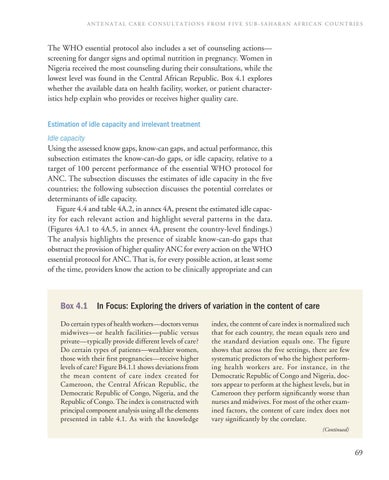A ntenatal C are C onsultations from F ive S ub - S aharan A frican C ountries
The WHO essential protocol also includes a set of counseling actions— screening for danger signs and optimal nutrition in pregnancy. Women in Nigeria received the most counseling during their consultations, while the lowest level was found in the Central African Republic. Box 4.1 explores whether the available data on health facility, worker, or patient characteristics help explain who provides or receives higher quality care. Estimation of idle capacity and irrelevant treatment Idle capacity Using the assessed know gaps, know-can gaps, and actual performance, this subsection estimates the know-can-do gaps, or idle capacity, relative to a target of 100 percent performance of the essential WHO protocol for ANC. The subsection discusses the estimates of idle capacity in the five countries; the following subsection discusses the potential correlates or determinants of idle capacity. Figure 4.4 and table 4A.2, in annex 4A, present the estimated idle capacity for each relevant action and highlight several patterns in the data. (Figures 4A.1 to 4A.5, in annex 4A, present the country-level findings.) The analysis highlights the presence of sizable know-can-do gaps that obstruct the provision of higher quality ANC for every action on the WHO essential protocol for ANC. That is, for every possible action, at least some of the time, providers know the action to be clinically appropriate and can
Box 4.1 In Focus: Exploring the drivers of variation in the content of care Do certain types of health workers—doctors versus midwives—or health facilities—public versus private—typically provide different levels of care? Do certain types of patients—wealthier women, those with their first pregnancies—receive higher levels of care? Figure B4.1.1 shows deviations from the mean content of care index created for Cameroon, the Central African Republic, the Democratic Republic of Congo, Nigeria, and the Republic of Congo. The index is constructed with principal component analysis using all the elements presented in table 4.1. As with the knowledge
index, the content of care index is normalized such that for each country, the mean equals zero and the standard deviation equals one. The figure shows that across the five settings, there are few systematic predictors of who the highest performing health workers are. For instance, in the Democratic Republic of Congo and Nigeria, doctors appear to perform at the highest levels, but in Cameroon they perform significantly worse than nurses and midwives. For most of the other examined factors, the content of care index does not vary significantly by the correlate. (Continued)
69

